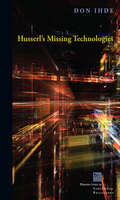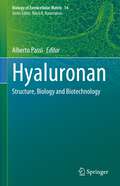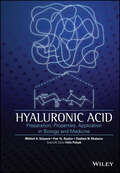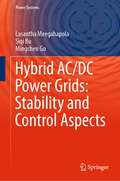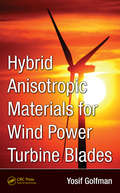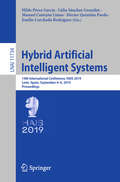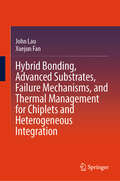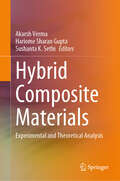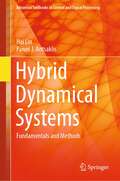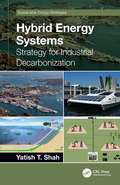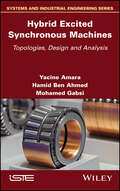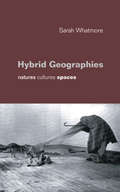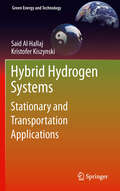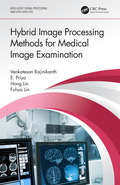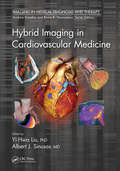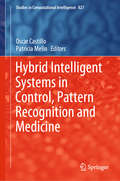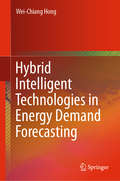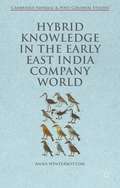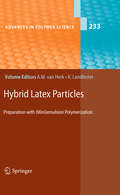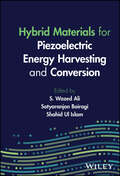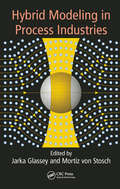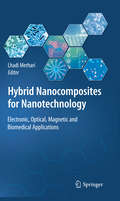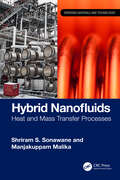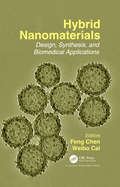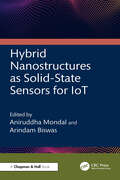- Table View
- List View
Husserl's Missing Technologies (Perspectives in Continental Philosophy)
by Don IhdeHusserl’s Missing Technologies looks at the early-twentieth-century “classical” phenomenology of Edmund Husserl, both in the light of the philosophy of science of his time, and retrospectively at his philosophy from a contemporary “postphenomenology.” Of central interest are his infrequent comments upon technologies and especially scientific instruments such as the telescope and microscope. Together with his analysis of Husserl, Don Ihde ventures through the recent history of technologies of science, reading and writing, and science praxis, calling for modifications to phenomenology by converging it with pragmatism. This fruitful hybridization emphasizes human–technology interrelationships, the role of embodiment and bodily skills, and the inherent multistability of technologies. In a radical argument, Ihde contends that philosophies, in the same way that various technologies contain an ever-shortening obsolescence, ought to have contingent use-lives.
Hyaluronan: Structure, Biology and Biotechnology (Biology of Extracellular Matrix #14)
by Alberto PassiThis book addresses the structural and biological properties of the extracellular matrix component and glycosaminoglycan polymer hyaluronan (or hyaluronic acid, HA).The book discusses various aspects of HA biology, e.g., HA synthesis and degradation, as well as the role of HA in embryogenesis, development, and cell maintenance. The reader will learn about the role of HA in different tissues as well as its biological activities triggered by the interaction with different HA receptors. A closer look is had at the involvement of HA in human pathologies such as cancer, kidney fibrosis and wound healing. Biotechnological and biomedical applications for HA such as scaffold generation and drug delivery, including the novel synthetic sulphated HA are explored.This work will appeal to a wide readership within the extracellular matrix and hyaluronan field. It can serve as an introduction to the field for junior scientists but can also help senior scientists to gain a broader view of the field beyond their area of specialization.The series Biology of Extracellular Matrix is published in collaboration with the American Society for Matrix Biology and the International Society for Matrix Biology.
Hyaluronic Acid
by V. N. Khabarov P. Y. Boykov Felix Polyak M. A. SelyaninHyaluronic acid is an essential part of connective, epithelial and neural tissues, and contributes to cell proliferation and migration. It is used as a stimulating agent for collagen synthesis and is a common ingredient in skin-care products, a multi-billion dollar industry, as it is believed to be a key factor in fighting the aging process.Hyaluronic Acid: Production, Properties, Application in Biology and Medicine consists of six chapters discussing the various issues of hyaluronic acid research. In Chapter 1, a historical analysis recounts the discovery and milestones of the research leading to the practical applications of hyaluronan. Chapter 2 is dedicated to biological role of the hyaluronic acid in nature, in particular in the human body. The chapter starts from the phylogenesis of hyaluronic acid, then describes hyaluronan functions in human ontogenesis and especially the role which hyaluronan plays in extracellular matrix of the different tissues. Chapter 3 describes the methods to manufacture and purify hyaluronic acid, including the analytical means for assessing quality of the finished product. Chapter 4 discusses the structure and rheological properties of hyaluronic acid considering effects on conformation and biological properties related to molecular weight. In Chapter 5, the physical and chemical methods for modifying the structure of hyaluronan are discussed including cross-linking using bi-functional reagents, solid-phase modification and effects of the combined action of high pressures and shift deformation. The final chapter focuses on the products derived from hyaluronic acid, including therapeutics composed of modified hyaluronan conjugated to vitamins, amino acids and oligo-peptides. The biological roles and medical applications of this polysaccharide have been extensively studied and this book provides a wealth of scientific data demonstrating the critical role of hyaluronic acid and its promise as a multifaceted bio-macromolecule.Approaching hyaluronic acid from multiple angles, this book links relationships between its biological functions, structure and physical-chemical properties. It will be an invaluable resource to researchers, both industrial and academic, involved in all aspects of hyaluronan-based technologies.
Hybrid AC/DC Power Grids: Stability and Control Aspects (Power Systems)
by Siqi Bu Lasantha Meegahapola Mingchen GuThis book covers modeling, control and stability aspects of hybrid AC/DC power networks. More specifically, this book provides an in-depth analysis of the stability and control aspects of hybrid AC/DC power grids, with comprehensive coverage of theoretical aspects of conventional stability issues (e.g., small-signal stability, voltage stability and frequency stability), emerging stability issues (e.g., converter associated stability) and control strategies applied in this emerging hybrid AC/DC power grids. This book takes a more pragmatic approach with a unique compilation of timely topics related to hybrid AC/DC networks compared with other books in this field. Therefore, this book provides the reader with comprehensive information on modeling, control and stability aspects which need to consider when modeling and analysis of hybrid AC/DC power grids for power system dynamics and stability studies. Each chapter provides fundamental stability theories, some worked examples and case studies to explain various modeling, analysis and control concepts introduced in the chapter. Therefore, postgraduate research students, power system researchers and power system engineers benefit from the materials presented in this book and assist them to model and device new control strategies to overcome the stability challenges of the emerging hybrid AC/DC power grid.
Hybrid Anisotropic Materials for Wind Power Turbine Blades
by Yosif GolfmanBased on rapid technological developments in wind power, governments and energy corporations are aggressively investing in this natural resource. Illustrating some of the crucial new breakthroughs in structural design and application of wind energy generation machinery, Hybrid Anisotropic Materials for Wind Power Turbine Blades explores new automat
Hybrid Artificial Intelligent Systems: 14th International Conference, HAIS 2019, León, Spain, September 4–6, 2019, Proceedings (Lecture Notes in Computer Science #11734)
by Hilde Pérez García Lidia Sánchez González Manuel Castejón Limas Héctor Quintián Pardo Emilio Corchado RodríguezThis volume constitutes the refereed proceedings of the 14th International Conference on Hybrid Artificial Intelligent Systems, HAIS 2019, held in León, Spain, in September 2019. The 64 full papers published in this volume were carefully reviewed and selected from 134 submissions. They are organized in the following topical sections: data mining, knowledge discovery and big data; bio-inspired models and evolutionary computation; learning algorithms; visual analysis and advanced data processing techniques; data mining applications; and hybrid intelligent applications.
Hybrid Bonding, Advanced Substrates, Failure Mechanisms, and Thermal Management for Chiplets and Heterogeneous Integration
by Xuejun Fan John LauThe book focuses on the design, materials, process, fabrication, failure mechanism, reliability, modeling, and thermal management of chiplets and heterogeneous integration. Both principles and engineering practice have been addressed, with more weight placed on engineering practice. This is achieved by providing in-depth study on a number of major topics such as hybrid bonding, advanced substrates, failure mechanisms, and modeling due to thermal stresses, moisture absorption, impact loading such as drop as well as electric current driven electromigration, and the fundamentals of thermal management. Each topic is treated with in-depth analysis to bridge foundational principles with real-world engineering challenges. This book is an essential resource for researchers, engineers, and students in electrical engineering, mechanical engineering, materials science, and industrial engineering, equipping them with the knowledge to advance innovation in semiconductor packaging and integration.
Hybrid Composite Materials: Experimental and Theoretical Analysis
by Akarsh Verma Sushanta K. Sethi Hariome Sharan GuptaThe aim of this book is to provide readers with a better understanding of the experimental methods and computational modeling techniques employed in the characterizations of diverse hybrid composite materials. It covers the mechanisms, important aspects, characteristics, formulations, significant elements, and case studies of the hybrid composite materials used in a wide range of applications. To inspire researchers, the most recent studies in the field as well as potential directions for more study are also emphasized.
Hybrid Dynamical Systems: Fundamentals and Methods (Advanced Textbooks in Control and Signal Processing)
by Hai Lin Panos J. AntsaklisA graduate-level textbook, Hybrid Dynamical Systems provides an accessible and comprehensive introduction to the theory of hybrid systems. It emphasizes results that are central to a good understanding of the importance and role of such systems. The authors have developed the materials in this book while teaching courses on hybrid systems, cyber-physical systems, and formal methods.This textbook helps students to become familiar with both the major approaches coloring the study of hybrid dynamical systems. The computer science and control systems points of view – emphasizing discrete dynamics and real time, and continuous dynamics with switching, respectively – are each covered in detail.The book shows how the behavior of a system with tightly coupled cyber- (discrete) and physical (continuous) elements can best be understood by a model simultaneously encompassing all the dynamics and their interconnections. The theory presented is of fundamental importance in a wide range of emerging fields from next-generation transportation systems to smart manufacturing.Features of the text include:extensive use of examples to illustrate the main concepts and to provide insights additional to those acquired from the main text;chapter summaries enabling students to assess their progress;end-of-chapter exercises, which test learning as a course proceeds;an instructor’s guide showing how different parts of the book can be exploited for different course requirements; anda solutions manual, freely available for download by instructors adopting the book for their teaching.Access to MATLAB and Stateflow is not required but would be beneficial, especially for exercises in which simulations are a key tool.
Hybrid Energy Systems: Strategy for Industrial Decarbonization (Sustainable Energy Strategies)
by Yatish T. ShahHybrid Energy Systems: Strategy for Industrial Decarbonization demonstrates how hybrid energy and processes can decarbonize energy industry needs for power and heating and cooling. It describes the role of hybrid energy and processes in nine major industry sectors and discusses how hybrid energy can offer sustainable solutions in each. Introduces the basics and examples of hybrid energy systems Examines hybrid energy and processes in coal, oil and gas, nuclear, building, vehicle, manufacturing and industrial processes, computing and portable electronic, district heating and cooling, and water sectors Shows that hybrid processes can improve efficiency and that hybrid energy can effectively insert renewable fuels in the energy industry Serves as a companion text to the author’s book Hybrid Power: Generation, Storage, and Grids Written for advanced students, researchers, and industry professionals involved in energy-related processes and plants, this book offers latest research and practical strategies for application of the innovative field of hybrid energy.
Hybrid Excited Synchronous Machines: Topologies, Design and Analysis
by Yacine Amara Mohamed Gabsi Hamid Ben AhmedHybrid Excited Synchronous Machines: Topologies, Design and Analysis
Hybrid Geographies: Natures Cultures Spaces (Human Geography Ser.)
by Sarah Whatmore`Hybrid Geographies is one of the most original and important contributions to our field in the last 30 years. At once immensley provocative and productive, it is written with uncommon clarity and grace, and promises to breathe new life not only into geographical inquiry but into critical practice across the spectrum of the humanities and social sciences - and beyond. An extraordinary achievement' - Professor Derek Gregory, Department of Geography, University of British Columbia Hybrid Geographies critically examines the `opposition' between nature and culture, the material and the social, as represented in scientific, environmental and popular discourses. Demonstrating that the world is not an exclusively human achievement, Hybrid Geographies reconsiders the relation between human and non-human, the social and the material, showing how they are intimately and variously linked. General arguments - informed by work in critical geography, feminist theory, environmental ethics, and science studies - are illustrated throughout with detailed case-study material. This exemplifies the two core themes of the book: a consideration of hybridity (the human/non-human relation) and of the `fault-lines' in the spatial organization of society and nature. Hybrid Geographies is essential reading for students in the social sciences with an interest in nature, space and social theory.
Hybrid Hydrogen Systems
by Said Al-Hallaj Kristofer KiszynskiHybrid Hydrogen Systems for Stationary and Transportation Applications presents an original, comprehensive approach to hybrid energy system optimization and provides a much-needed systems approach to hydrogen energy applications. This textbook will be bought by graduate and senior undergraduate students studying renewable energy and the design and optimisation of hydrogen energy systems as well as the lecturers who teach these subjects. Hybrid Hydrogen Systems for Stationary and Transportation Applications will also be bought by researchers and practitioners working with hydrogen and fuel cells as well as policy makers and advocates of renewable energy.
Hybrid Image Processing Methods for Medical Image Examination (Intelligent Signal Processing and Data Analysis)
by Hong Lin Venkatesan Rajinikanth E Priya Fuhua LinIn view of better results expected from examination of medical datasets (images) with hybrid (integration of thresholding and segmentation) image processing methods, this work focuses on implementation of possible hybrid image examination techniques for medical images. It describes various image thresholding and segmentation methods which are essential for the development of such a hybrid processing tool. Further, this book presents the essential details, such as test image preparation, implementation of a chosen thresholding operation, evaluation of threshold image, and implementation of segmentation procedure and its evaluation, supported by pertinent case studies. Aimed at researchers/graduate students in the medical image processing domain, image processing, and computer engineering, this book: Provides broad background on various image thresholding and segmentation techniques Discusses information on various assessment metrics and the confusion matrix Proposes integration of the thresholding technique with the bio-inspired algorithms Explores case studies including MRI, CT, dermoscopy, and ultrasound images Includes separate chapters on machine learning and deep learning for medical image processing
Hybrid Imaging in Cardiovascular Medicine (Imaging in Medical Diagnosis and Therapy)
by Yi-Hwa Liu Albert J. SinusasThis comprehensive book focuses on multimodality imaging technology, including overviews of the instruments and methods followed by practical case studies that highlight use in the detection and treatment of cardiovascular diseases. Chapters cover PET-CT, SPECT-CT, SPECT-MRI, PET-MRI, PET-optical imaging, SPECT-optical imaging, photoacoustic Imaging, and hybrid intravascular imaging. It also addresses the important issues of multimodality imaging probes and image quantification. <P><P>Readers from radiology and cardiology as well as medical imaging and biomedical engineering will learn essentials of the field. They will be shown how the field has advanced quantitative analysis of molecularly targeted imaging through improvements in the reliability and reproducibility of imaging data. Moreover, they will be presented with quantification algorithms and case illustrations, including coverage of such topics such as multimodality image fusion and kinetic modeling. <P><P>Yi-Hwa Liu, PhD is Senior Research Scientist in Cardiovascular Medicine at Yale University School of Medicine and Technical Director of Nuclear Cardiology at Yale New Haven Hospital. He is also an Associate Professor (Adjunct) of Biomedical Imaging and Radiological Sciences at National Yang-Ming University, Taipei, Taiwan, and Professor (Adjunct) of Biomedical Engineering at Chung Yuan Christian University, Taoyuan, Taiwan. He is an elected senior member of Institute of Electrical and Electronic Engineers (IEEE) and a full member of Sigma Xi of The Scientific Research Society of North America. <P><P>Albert J. Sinusas, M.D., FACC, FAHA is Professor of Medicine (Section of Cardiovascular Medicine) and Radiology and Biomedical Imaging, at Yale University School of Medicine, and Director of the Yale Translational Research Imaging Center (Y-TRIC), and Director of Advanced Cardiovascular Imaging at Yale New Haven Hospital. He is a recipient of the Society of Nuclear Medicine’s Hermann Blumgart Award.
Hybrid Intelligent Systems in Control, Pattern Recognition and Medicine (Studies in Computational Intelligence #827)
by Oscar Castillo Patricia MelinThis book describes the latest advances in fuzzy logic, neural networks and optimization algorithms, as well as their hybrid combinations, and their applications in areas such as: intelligent control and robotics, pattern recognition, medical diagnosis, time series prediction, and optimization of complex problems. The book is divided into five main parts. The first part proposes new concepts and algorithms based on type-1 and type-2 fuzzy logic and their applications; the second explores new concepts and algorithms in neural networks and fuzzy logic applied to recognition. The third part examines the theory and practice of meta-heuristics in various areas of application, while the fourth highlights diverse applications of fuzzy logic, neural networks and hybrid intelligent systems in medical contexts. Finally, the fifth part focuses on applications of fuzzy logic, neural networks and meta-heuristics to robotics problems.
Hybrid Intelligent Technologies in Energy Demand Forecasting
by Wei-Chiang HongThis book is written for researchers and postgraduates who are interested in developing high-accurate energy demand forecasting models that outperform traditional models by hybridizing intelligent technologies. It covers meta-heuristic algorithms, chaotic mapping mechanism, quantum computing mechanism, recurrent mechanisms, phase space reconstruction, and recurrence plot theory. The book clearly illustrates how these intelligent technologies could be hybridized with those traditional forecasting models. This book provides many figures to deonstrate how these hybrid intelligent technologies are being applied to exceed the limitations of existing models.
Hybrid Knowledge in the Early East India Company World (Cambridge Imperial and Post-Colonial Studies Series)
by Anna WinterbottomHybrid Knowledge in the Early East India Company World presents a new interpretation of the development of the English East India Company between 1660 and 1720. The book explores the connections between scholarship, patronage, diplomacy, trade, and colonial settlement in the early modern world. Links of patronage between cosmopolitan writers and collectors and scholars associated with the Royal Society of London and the universities are investigated. Winterbottom shows how innovative works of scholarship – covering natural history, ethnography, theology, linguistics, medicine, and agriculture - were created amid multi-directional struggles for supremacy in Asia, the Indian Ocean and the Atlantic. The role of non-elite actors including slaves in transferring knowledge and skills between settlements is explored in detail.
Hybrid Latex Particles
by Alex M. Herk Katharina LandfesterHistorical Overview of (Mini)emulsion Polymerizations and Preparation of Hybrid Latex Particles, by A.M. van Herk; * Physical Methods for the Preparation of Hybrid Nanocomposite Polymer Latex Particles, by R. F.A. Teixeira and S. A.F. Bon; * Organic/Inorganic Composite Latexes: The Marriage of Emulsion Polymerization and Inorganic Chemistry, by Elodie Bourgeat-Lami and Muriel Lansalot; * Preparation of Hybrid Latex Particles and Core-Shell Particles Through the Use of Controlled Radical Polymerization Techniques in Aqueous Media, by Bernadette Charleux, Franck D'Agosto, and Guillaume Delaittre; * Miniemulsion Polymerization as a Means to Encapsulate Organic and Inorganic Materials, by Clemens K.Weiss and Katharina Landfester; * Organic-Inorganic Hybrid Magnetic Latex, by Md Mahbubor Rahman and Abdelhamid Elaissari
Hybrid Materials for Piezoelectric Energy Harvesting and Conversion
by Shahid Ul Islam S. Wazed Ali Satyaranjan BairagiHybrid Materials for Piezoelectric Energy Harvesting and Conversion Power small devices more efficiently and practically with these essential materials Piezoelectric energy harvesting is an increasingly widely-deployed technique to generate electricity from mechanical energy. Reliability, ease of use, and cleanliness make piezoelectric energy harvesting in small electronic devices a potentially valuable alternative to the practical challenges and waste production of disposable or even reusable batteries. However, piezoelectric materials have their own challenges, advantages, and limitations, and choosing between them is a difficult engineering problem in itself; hybrid piezoelectric materials, which can be used to compensate the weaknesses of individual piezoelectric materials (like ceramic or polymer), are the emerging solution. Hybrid Materials for Piezoelectric Energy Harvesting and Conversion offers a systematic analysis of these hybrid piezoelectric materials and their applications. Each hybrid piezoelectric material is analyzed for its fundamentals, structural requirements, and applications, and the result is a significant contribution to materials science and electronic engineering. Hybrid Materials for Piezoelectric Energy Harvesting and Conversion readers will also find: Comprehensive coverage of piezoelectric materials to provide the best fit for any set of engineering needs Detailed discussion of inorganic, organic, and hybrid piezoelectric materials Surface modification of piezoelectric filler in composite based piezoelectric materials Importance of semiconductive and conductive materials in enhancing piezoelectric response of hybrid piezoelectric materials In depth analysis of bio-based hybrid piezoelectric materials Hybrid Materials for Piezoelectric Energy Harvesting and Conversion is ideal for researchers in materials sciences, polymers, textiles, green and renewable energy, and all related fields.
Hybrid Modeling in Process Industries
by Jarka Glassey and Moritz von StoschThis title introduces the underlying theory and demonstrates practical applications in different process industries using hybrid modeling. It reviews hybrid modeling approach applicability in wide range of process industries, recommends how to increase hybrid model performance and throw Insights into cost efficient practices in modeling techniques Discusses advance process operation maximizing the benefits of available process knowledge and Includes real-life and practical case studies
Hybrid Nanocomposites for Nanotechnology
by Lhadi MerhariThis book covers the latest advances in polymer-inorganic nanocomposites, with particular focus on high-added-value applications in fields including electronics, optics, magnetism and biotechnology. The unique focus of this book is on electronic, optical, magnetic and biomedical applications of hybrid nanocomposites. Coverage includes: Synthesis methods and issues and production scale-up; Characterization methods; Electronic applications; Optical applications and Photonics; Magnetic applications; and Biomedical applications. The book offers readers a solid grasp of the state of the art, and of current challenges in non-traditional applications of hybrid nanocomposites.
Hybrid Nanofluids: Heat and Mass Transfer Processes (Emerging Materials and Technologies)
by Shriram S. Sonawane Manjakuppam MalikaThis book provides a comprehensive understanding of advanced hybrid nanofluid applications in various fields while also explaining the real-time industrial applications of nanofluids. It explains mathematical, numerical, and experimental methodologies of application of the nanofluids in heat transfer and mass transfer processes. It helps build innovative nanofluid-based devices, including the study and measurement of thermophysical characteristics, convection, and heat transfer equipment performance.Features: Discusses hybrid nanofluids with a strong attention to the processes. Explores inter-relation between thermal properties, physical properties, and optical properties of the nanofluids. Investigates high-performance heat transfer and mass transfer hybrid nanofluids. Explores data for the design of the nanofluid application and scale-up challenges. Reviews industrial operation and scale-up challenges for nanofluid applications in the industrial process. This book is aimed at graduate students and researchers in fluid dynamics, nanotechnology, and chemical and mechanical engineering.
Hybrid Nanomaterials: Design, Synthesis, and Biomedical Applications
by Feng Chen Weibo CaiOver the last decade, an unprecedented expansion in the field of nanomedicine has resulted in the development of new nanomaterials for diagnosis and therapy of various diseases such as cancer. This book covers the design, synthesis and applications of various functionally-hybridized nanomaterials for biomedical applications. It includes strategies for design and synthesis of hybrid nanomaterials, surface engineering of various nanoparticle-based hybrid nanosystems for cancer imaging and therapy, toxicity aspects of nanomaterials and the challenges in translation research of hybrid nanomaterials.
Hybrid Nanostructures as Solid-State Sensors for IoT
by Arindam Biswas Aniruddha MondalThe book provides an in-depth discussion of various Hybrid Nanostructures as solid-state sensors in the context of the Internet of Things (IoT). It explains the vital role that sensors play in IoT to aid in discovering what possibilities ought to be addressed to make the data more meaningful. The book highlights the applicability of biosensing field effect transistor (FET) technology with a specific emphasis on the progress being made in integrating existing FET technology and nanotechnology, using semiconductor nanowires and organic structures.• Offers in-depth discussion on Hybrid Nanostructures as solid-state sensors• Elaborates upon the fabrication of gas sensors using metal oxide semiconductor nanostructures• Studies biosensors based on metal oxide semiconductor nanostructures• Discusses the suitability of various Hybrid Sensors in solving the problems of the Internet of Things (IoT)• Provides extensive support for the development of Hybrid Nanostructures as solid-state sensorsThe book is meant for researchers and scholars of Computer Science and associated disciplines. It also serves as a valuable reference for graduate students, researchers, seeking to deepen their knowledge and engage with the latest advancements in these Hybrid Nanostructures as solid-state sensors.
